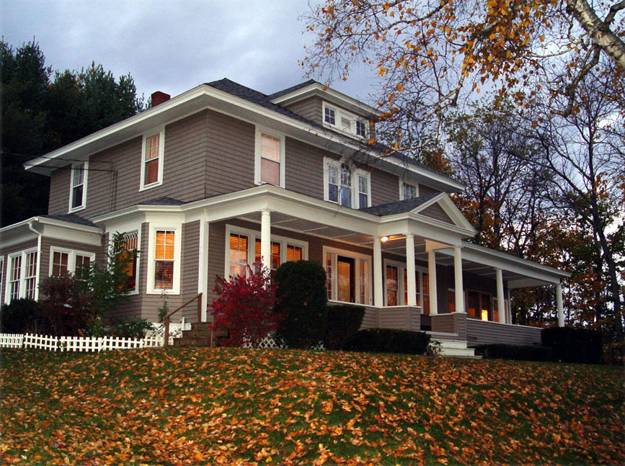Attracting Homebuyers in the Winter Months
 As temperatures drop, snow piles up and people’s minds turn to holiday celebrations, you may think that your house won’t sell. In fact, many people take their homes off the market during this time and wait for spring to relist them. Unfortunately, not everyone has the luxury of waiting. If you need to sell your home now, consider changing up what you’re offering.
As temperatures drop, snow piles up and people’s minds turn to holiday celebrations, you may think that your house won’t sell. In fact, many people take their homes off the market during this time and wait for spring to relist them. Unfortunately, not everyone has the luxury of waiting. If you need to sell your home now, consider changing up what you’re offering.
Location, location, location
Especially in winter, a home’s location is important. So, if your home is near to public transportation access and major roads likely to be kept plowed or cleared, or conversely, it is near to winter sports and recreation, highlight those facts as selling points. Easy access to the places they want to go is one way to attract winter buyers.
Don’t neglect curb appeal
While a blanket of snow can cover a host of landscaping issues, make sure your home looks well cared for when buyers pull up to the curb. Make sure walks are clean, gutters are clear and the exterior is well lighted. Remove any debris or piles of leaves. You want your home to look well kept no matter the season.
Add festive décor, such as a wreath on the door or greenery on your mantel, but don’t go overboard. To appeal to the widest possible audience, your decorations should be less personal and neutral.
When house hunters visit your home in inclement weather, make sure to have a welcoming atmosphere in your house. Leave warm beverages or homemade cookies for them. Light fireplaces and candles. Make sure your home is warm, light and bright.
Price your home right
While this is true at any time of the year, make sure your price reflects both the value of your home and the winter market expectations. People that need to buy and move during the winter months often have specific budget constraints. Otherwise, they might choose to wait for a more convenient time of year. Consider offering incentives or concessions for closing costs, new appliances, home improvements or repairs such as furnace repair, or other items to sweeten the deal for potential buyers. However, before the winter hits, you will most definitely need a plumber to stop by and seal any pipes that may be leaking, even if they are just tiny drops. That way you prevent any ice dams that may build and cause water damage when they melt in the warmer weather.
Use a professional
During the winter months, selling on your own may not be the best strategy. Professional real estate agents have access to several advertising channels. They more likely know how to highlight your home’s best selling points, as well as provide a few recommendations on certain issues such as plumbing that it would be worth your while to repair in order to give your home a much better chance. Most of all, they have access to buyers such as those moving to your area for a new job, or investors looking to make a purchase before the end of the year. Knowing how to target the right buyer or investor is one of the many advantages a professional can bring to a home sale.
Compliments of Virtual Results




 Gone are the days of the sticky painted kitchen cabinet that peels, chips and generally looks cheap. Modern paint finishes means you can rejuvenate or renovate your dated kitchen or bath cabinets with just some elbow grease and your own creativity. Painting your cabinets is a project that homeowners should consider when planning
Gone are the days of the sticky painted kitchen cabinet that peels, chips and generally looks cheap. Modern paint finishes means you can rejuvenate or renovate your dated kitchen or bath cabinets with just some elbow grease and your own creativity. Painting your cabinets is a project that homeowners should consider when planning  As you think about gift-giving this season, don’t forget to give your new home a gift of its own. Advancements in technology mean that your home can be smarter, cleaner, cooler or the hottest thing on the market. Here are some ideas for you that are available now or may be coming on the market in the future. Get them on your wish list early.
As you think about gift-giving this season, don’t forget to give your new home a gift of its own. Advancements in technology mean that your home can be smarter, cleaner, cooler or the hottest thing on the market. Here are some ideas for you that are available now or may be coming on the market in the future. Get them on your wish list early.
 Each year, fire departments across the country respond to home and structure fires caused by holiday decorations. In a study by the National Fire Protection Association (
Each year, fire departments across the country respond to home and structure fires caused by holiday decorations. In a study by the National Fire Protection Association (

 To have an open house or not to have an open house over the Thanksgiving weekend: that is the question! Many sellers assume that the Thanksgiving holiday weekends and the week between Christmas and New Years Day are less than favorable times to have an open house. Some real estate agents disagree.
To have an open house or not to have an open house over the Thanksgiving weekend: that is the question! Many sellers assume that the Thanksgiving holiday weekends and the week between Christmas and New Years Day are less than favorable times to have an open house. Some real estate agents disagree.







 Catch Our Feed
Catch Our Feed Subscribe via Email
Subscribe via Email Follow Our Tweets
Follow Our Tweets Friend Us On Facebook
Friend Us On Facebook Watch Us On Youtube
Watch Us On Youtube